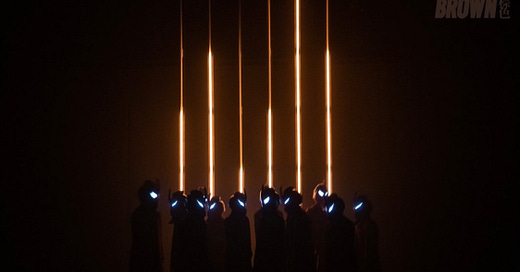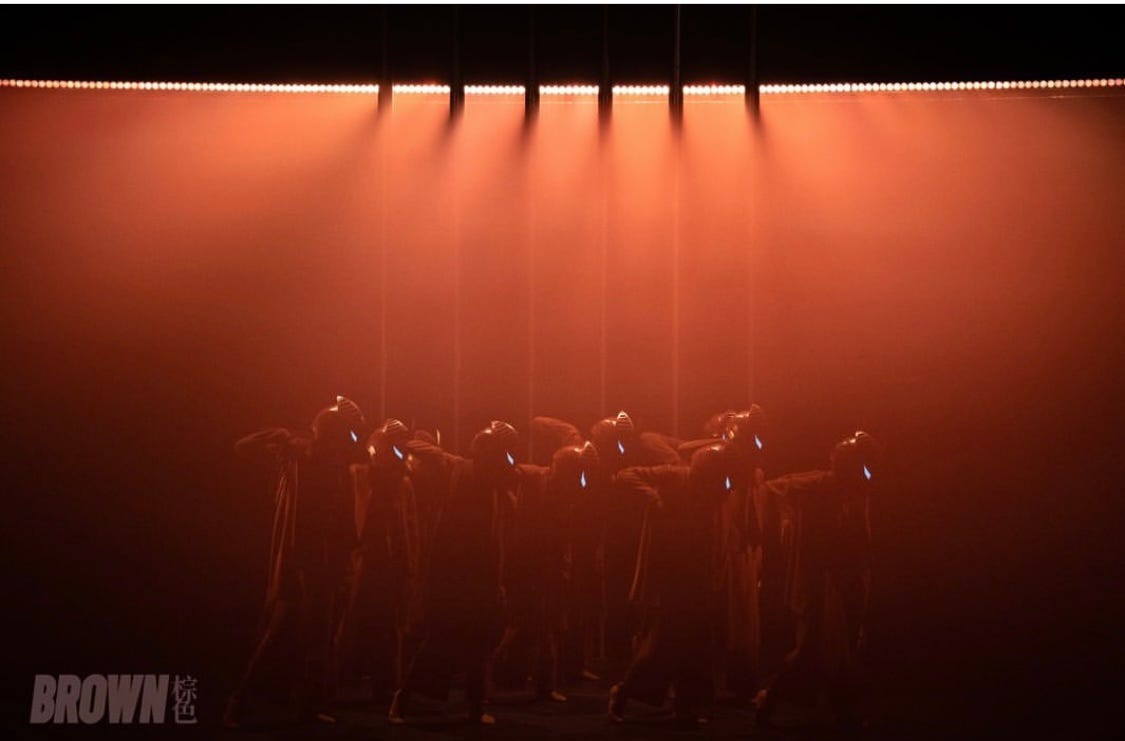By Martina M E Manalo
17 December 2022
A little different from the old CCDC I remember seeing a few years ago (which I think is a good thing), although not quite what I expected. Kim Jaeduk’s concept was slightly more than just another ‘east meets west’ cliché—the choreographer’s work talked about the possibilities of movements through time by adding colour into it—brown that represents both traditional and modern. Having a great concept and vision is one thing, but bringing a concept to life and how it is presented in a specific medium, is another story.
As the stage lights went on, I immediately thought of how interesting the first few seconds of it looked—a minimalist modern set design that somehow reminded me of American minimalist artist Dan Flavin, and a touch of modern surrealism for their costume, while the ambient music started playing…and that was it. It was followed by a long, dragging, and repetitive prologue before it finally got to the good part. I find that too much of these repetitions in choreographic works, seem to take away the innovation of movements as the excitement just easily slips away.
The first half of it was spent by showcasing more 'effects’ rather than the actual dancing itself—canon after canon after canon and some synchronised movements, and more canon, and so on. In such instances of moving in unison, and especially that it was a group dance, I wished to have seen a lot more synchronicity from the dancers, and straight lines that didn’t have one or two dancers sticking completely out of line multiple times. I find these little details very, very crucial when doing any kind of corps work. It can be the hardest role for dancers but they often don’t see it—harder than principal roles, to be honest. Corps work has to be precise in timing and dancers have to move as one—moving off-beat is just like someone singing off-key, and I’m pretty sure I don’t want to hear any singer singing off key.
Towards the end of the piece, masks and coats were off, and the real dancing began. It’s always lovely to see some young dancers making it to the real dance world like Natalie Ko, who was exciting to see on stage, showcasing her strengths and her infectious high energy and movements that are very clean and definite. Natalie is the kind of dancer who leaves a good impression on the audience. And then there’s guest performer Florence Woo, back in her element showcasing her forte in contemporary dance, without a doubt an impressively strong dancer who makes things look so easy, moves flawlessly and always dances with such gusto . Another dancer who caught my attention was Peggy Lam. More than just a good mover, Peggy knows how to connect with the audience. It is said that dancers are story tellers who use their body to communicate, but more than that, to be able to communicate and tell the story to their audience. Like actors, dancers need to communicate with their eyes as this is part of the whole artistry which I think most of the dancers in this generation seem to forget that dance is art and not a competition of who can lift their legs higher or turn more or do the most difficult ‘tricks’ in dance.
Having a great concept and vision is one thing, but bringing a concept to life and how it is presented in dance, can sometimes be a tricky thing for both the choreographer, and the dance artists. Dance performances, just like theatre, singing, and anything that is live can never really be perfected. You can either do extremely well or mess up and that’s what your audience will remember you by. Despite having multiple shows, whatever you do, and whatever happens in each show, is going to be different—different show, different audience—different audience, different opinion. As a dance company with quite strong and multifaceted dancers (not to sound sexist—but it was mainly the women who stood out in this piece) ‘Brown’, however, could have been more riveting than what the paper says, if the dancers’ capabilities were used a lot more than they did. Remember that it’s a dance company, not a mime production, therefore, I wish there was more dancing—and dancing with synchronicity and musicality (no matter how abstract the music can be), because not being able to move with the music is just movement, and not dance.
About the Writer
Martina M. E. Manalo is a multidisciplinary artist from the Philippines who currently works in Hong Kong. She is a former professional ballet dancer and faculty of Ballet Manila and has joined the Royal New Zealand Ballet for a short stint in 2013. She is also a recipient of the ‘Young Achiever Award for Dance and Ballet Excellence’ in 2006 during the Global Excellence Awards. The artist/writer is currently teaching ballet, jazz and contemporary. Her contemporary works have recently been shown in London, Wales, Hong Kong, Manila, Berlin, and New York. Martina is also a photographer and mixed-media artist with works previously shown in Manila, and Tokyo.
in case you missed…






